Local Area Labour Markets in Scotland: Statistics from the Annual Population Survey, 2014
Summary publication of results from the Annual Population Survey 2014, presenting analysis on the labour market, education and training. Results are provided for Scotland and local authority areas in Scotland.
Section 1: People in Work
National Overview
Figure 1 - Employment rate (16-64), Scotland and UK, 2004-2014
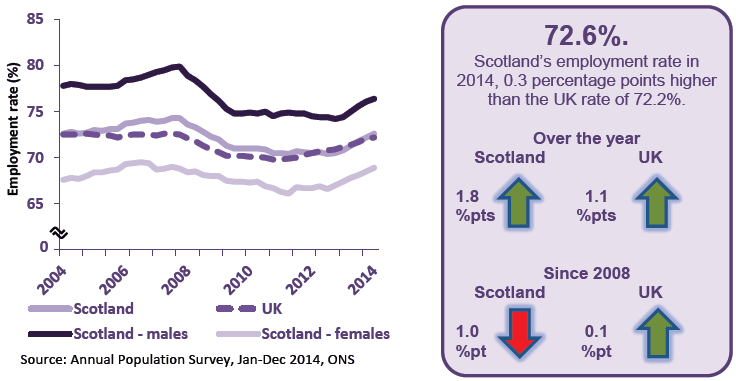
Source: Annual Population Survey, Jan-Dec 2014, ONS
Increases in employment rate over the year in Scotland have been driven by increases in both the male rate (up 2.1 percentage points from 74.4% to 76.4%) and the female rate (up 1.6 percentage points from 67.4% to 68.9%). The female employment rate of 68.9% in 2014 was the highest seen from the APS since Oct'07-Sep'08, when it was 68.8%. The male rate by comparison is still more than 3.0 percentage points lower than its Oct'07-Sep'08 record high of 79.9%.
Figure 2 - Employment level (16+), Scotland by gender, 2004-2014
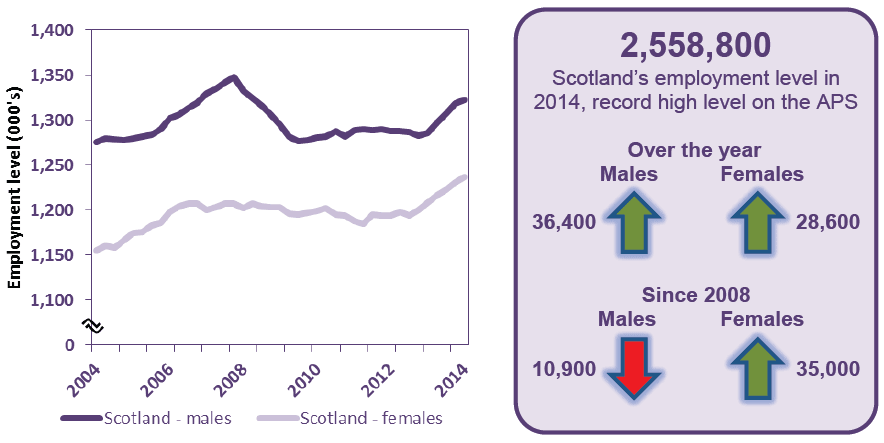
Source: Annual Population Survey, Jan-Dec 2014, ONS
The record high employment level in Scotland in 2014 was driven by female employment increasing to 1,236,800, the highest seen since comparable records began, and male employment levels rising to the highest since Apr'08-Mar'09 (1,321,900).
However, although employment levels are at record levels for both Scotland and females in Scotland, employment rates are not. This is due to the 16-64 population growing faster than 16-64 employment levels. In addition, much of the increase in employment levels (16+) have come from workers over the age of 65.
Figure 3 - Composition of the working population of Scotland in 2014
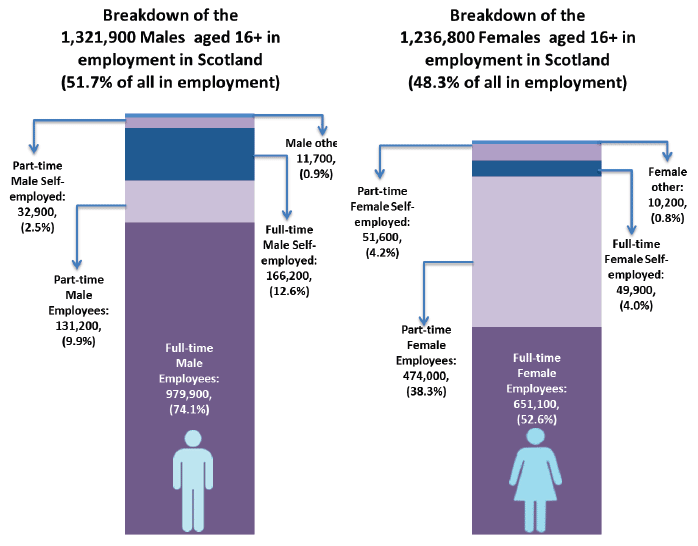
Source: Annual Population Survey, Jan-Dec 2014, ONS
Note: 'Other' category includes Government sponsored trainees, unpaid family workers and those whose job could not be classified as full or part-time
Figure 3 illustrates the different employment patterns for males and females, with female employees being far more likely to be working part-time than their male counterparts. Self-employed females are also almost twice as likely to be working part-time and around three times less likely to be working full-time than their male counterparts.
Local Area and sub group analysis
Employment rates vary considerably across the local authority areas of Scotland. Figure 4 below illustrates the variation seen in 2014 and how the gap between the 3 top and bottom performing areas, as measured by the Cohesion Purpose Target has changed over time.
The aim of the Cohesion Purpose Target[2] is to narrow the gap in participation between Scotland's best and worst performing regions by 2017.
Time series data for local authority areas are available in Table 1.1 of the accompanying web-tables.
Figure 4 - Employment rates across Local Authority areas, Scotland 2004-2014
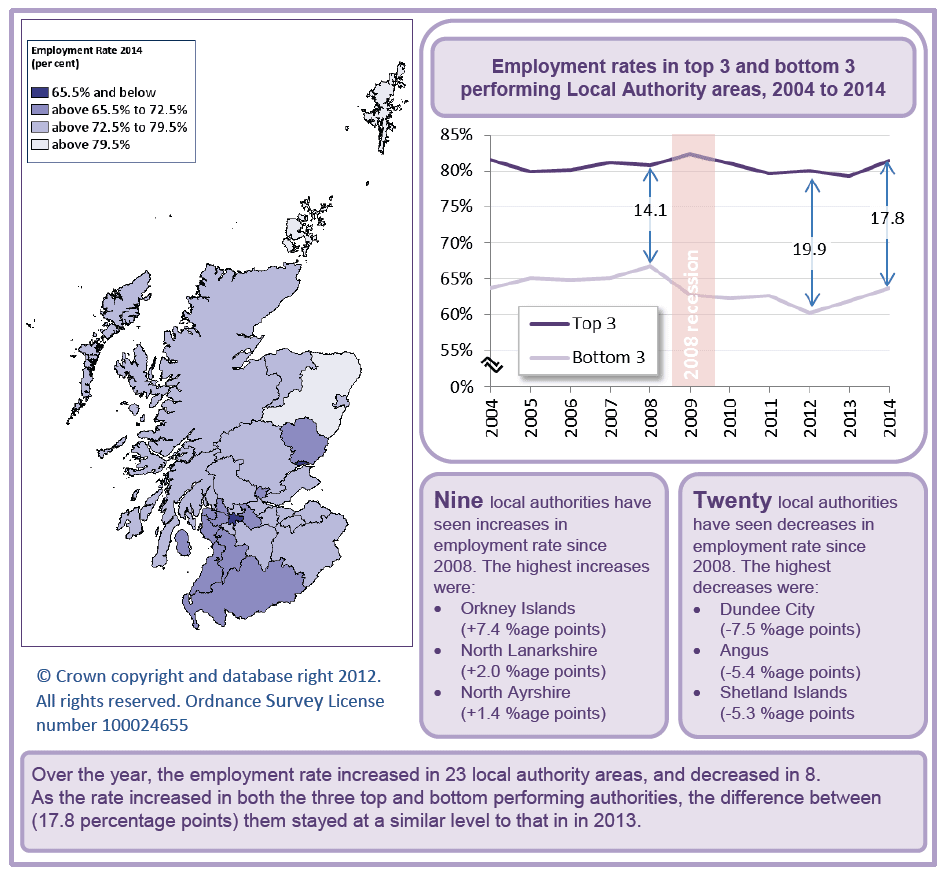
Source: Annual Population Survey, Jan-Dec 2014, ONS
Figure 5 - Male employment rates, change over year and since 2008, Scotland, UK
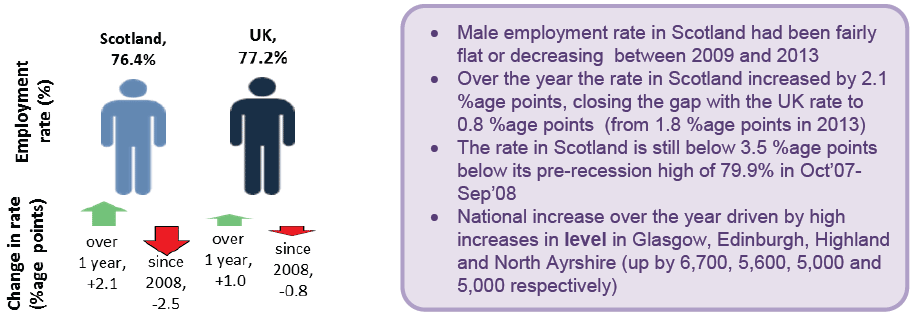
Source: Annual Population Survey, Jan-Dec 2014, ONS
Figure 6 - Female employment rates, change over year and since 2008, Scotland, UK
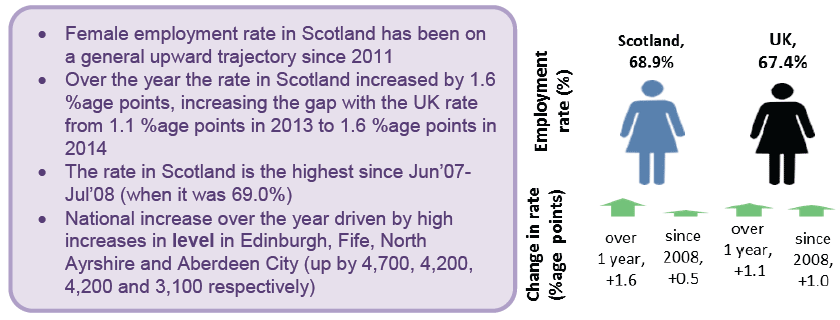
Source: Annual Population Survey, Jan-Dec 2014, ONS
Breakdown of male and female employment rates and level by local authority area are available from Tables 1.2 and 1.3 of the web-tables.
Figure 7 - Gender employment gap, Scotland and UK, 2004 to 2014
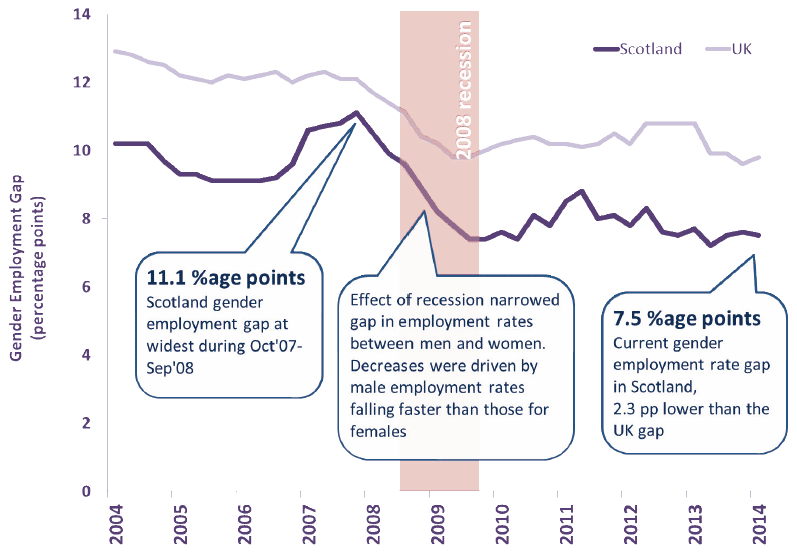
Source: Annual Population Survey, Jan-Dec 2014, ONS
The gender employment gap has reduced in part due to increases in female employment rates, which have increased as a result of welfare reform (e.g. changes in eligibility to Lone Parent Income Support and the on-going harmonisation of the male and female state pension age).
The gender employment rate gap was highest in 2014 in Aberdeenshire, Clackmannanshire and Highland (at 15.3, 13.9 and 13.5 percentage points respectively), while the lowest gaps were seen in Dundee City, Inverclyde and East Ayrshire (at -0.2, 2.8 and 3.0 percentage points respectively). City authorities generally tend to have a lower gender employment rate gap than more rural authorities which may point to greater availability of jobs, roles and work patterns that suit female workers in these areas.
Figure 8 - Employment rate (16-64) by Equality Act[3] disability status, Scotland, 2014
![Figure 8 - Employment rate (16-64) by Equality Act[3] disability status, Scotland, 2014 Figure 8 - Employment rate (16-64) by Equality Act[3] disability status, Scotland, 2014](/binaries/content/gallery/publications/statistics-publication/2015/05/local-area-labour-markets-scotland-statistics-annual-population-survey-2014/00478708.gif)
Source: Annual Population Survey, Jan-Dec 2014, ONS
Breakdown of employment rates and level for those with a disability by local authority area are available from Tables 1.5 of the web-tables. Note that this series has several discontinuities and some data may not be comparable over time.
Figure 9 - Employment rates by ethnicity, change over year and since 2008, Scotland
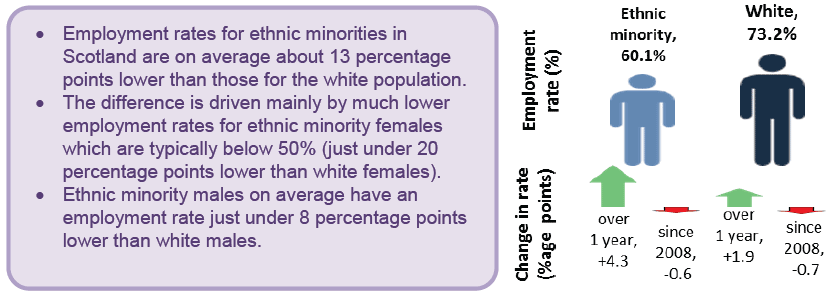
Source: Annual Population Survey, Jan-Dec 2014, ONS
Breakdown of employment rates and level by ethnicity and region are available from Tables 1.6 of the web-tables.
Figure 10 - Employment rate by age group, Scotland, 2004 to 2014
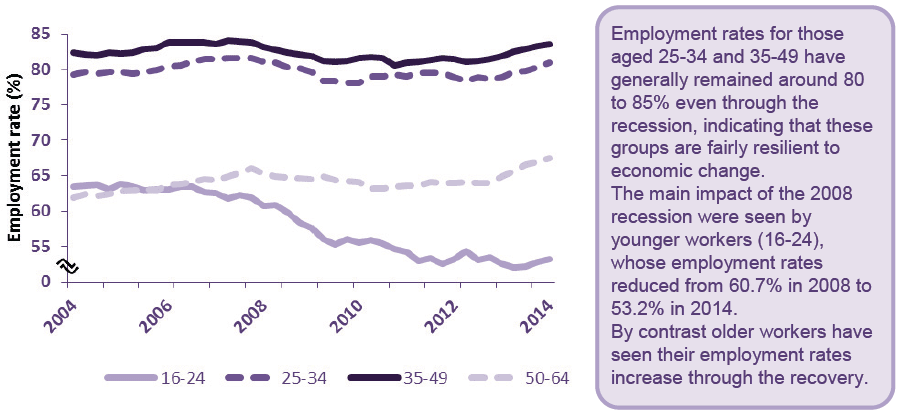
Source: Annual Population Survey, Jan-Dec 2014, ONS
Breakdown of employment rates and level by age and local authority area are available from Tables 1.4 of the web-tables.
Figure 11 - Employment rate by age group (16-24, 50-64 and 65+), change since 2008, Scotland
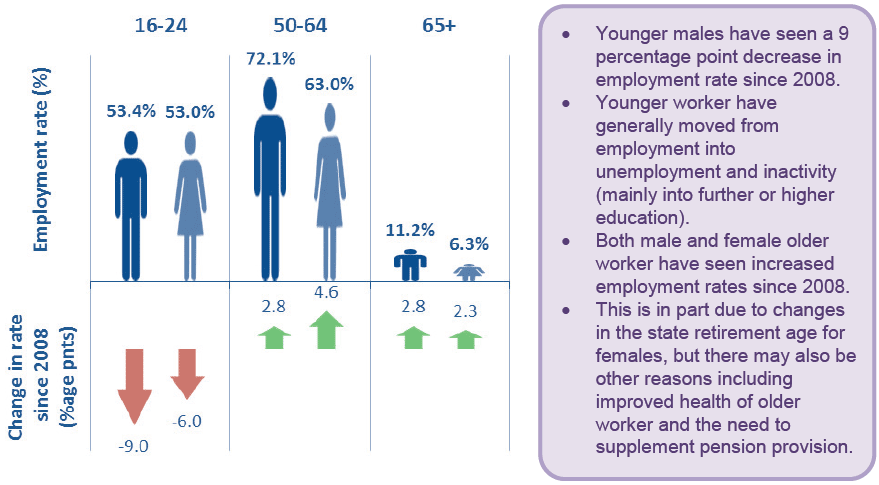
Source: Annual Population Survey, Jan-Dec 2014, ONS
Figure 12 - Youth employment (16-24) across Scotland and compared to the UK
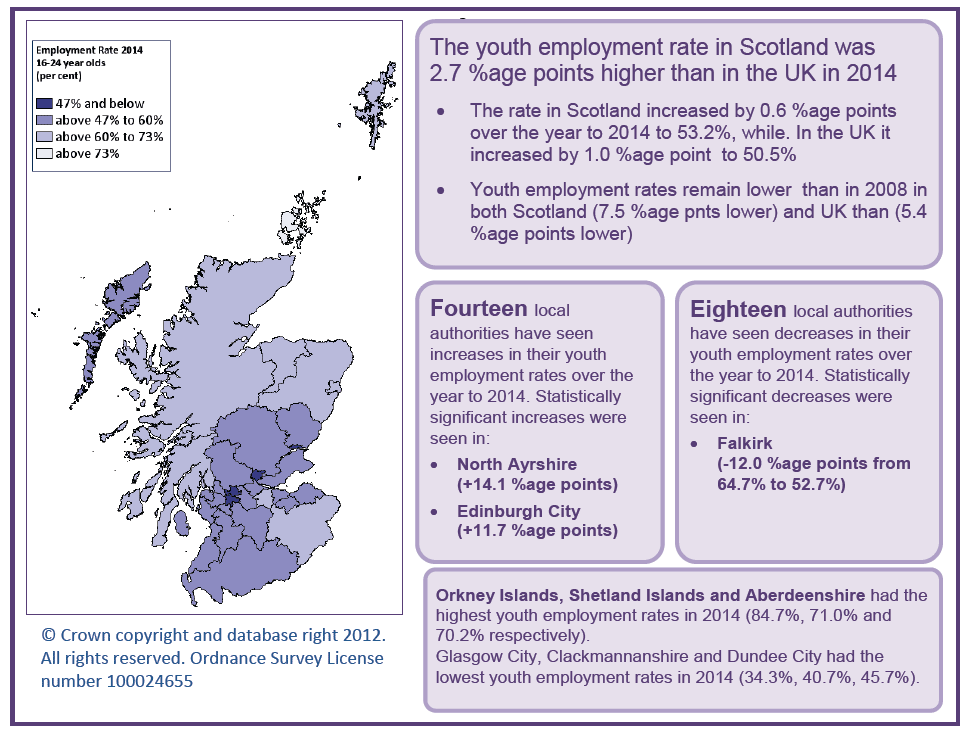
Source: Annual Population Survey, Jan-Dec 2014, ONS
Youth employment rates in some authorities will be affected by large student populations which can lead to higher inactivity levels and hence lower employment rates. In Scotland and the UK 44% of young people were in enrolled in full-time education in 2014. Of these, 33% in Scotland were also in employment, a higher proportion than in the UK (26%).
Figure 13 - Older Workers in Scotland, 2014
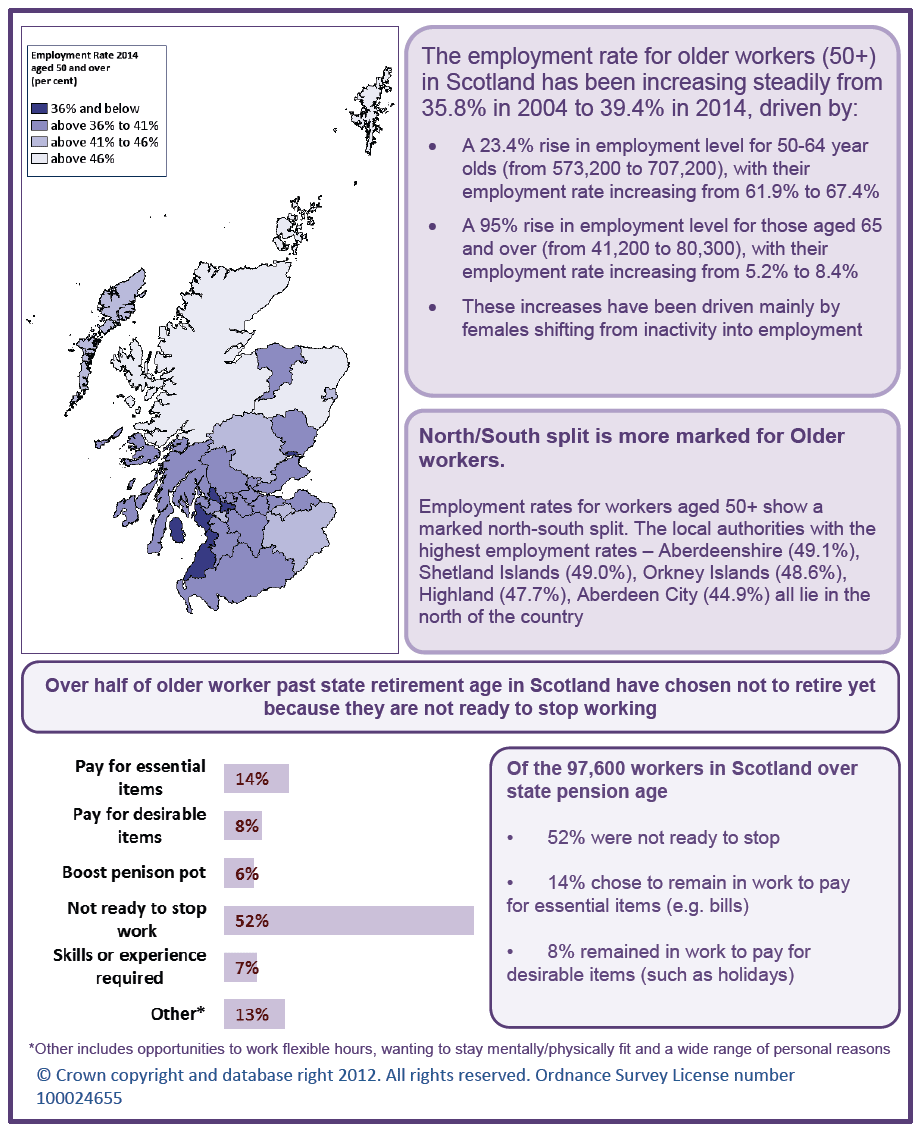
Source: Annual Population Survey, Jan-Dec 2014, ONS
Impact of education on employment
Figure 14 - Employment rates (16-64) by qualification level, Scotland 2004-2014
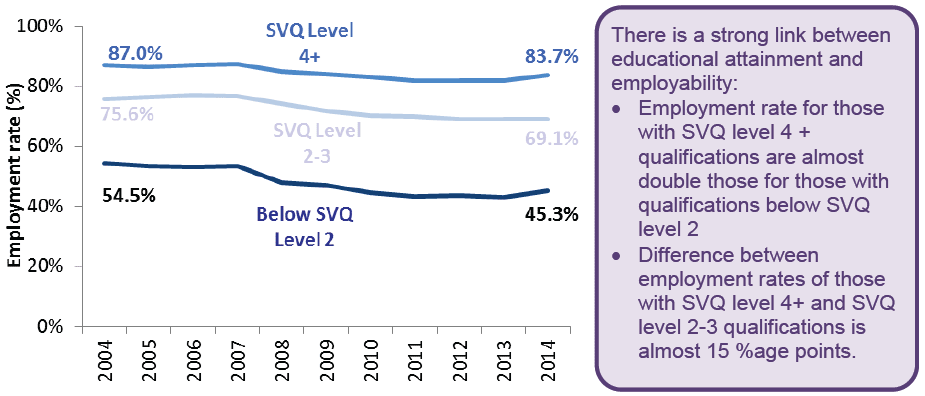
Source: Annual Population Survey, Jan-Dec 2014, ONS
Breakdown of employment rates and level by highest qualification and local authority area are available from Table 1.8 of the web-tables.
Figure 15 - Proportion of all in employment (16-64) by qualification level, Scotland 2004 to 2014
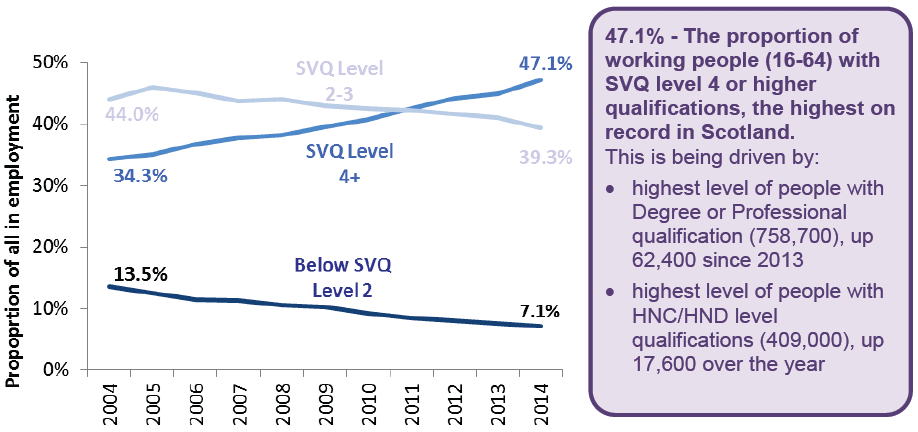
Source: Annual Population Survey, Jan-Dec 2014, ONS
The above charts point to an increasingly qualified workforce in Scotland, with data in the web-tables also pointing to the lowest level of working people aged 16-64 with no qualifications since comparable records began in 2004.
Those with SVQ level 4 and higher qualifications (or equivalent) remain the largest group in Scotland in 2014 at 47.1% (up 2.1 percentage points over the year). In the UK, the largest group is those with SVQ level 2 or 3 (or equivalent) qualifications at 43.7% (down 0.2 percentage points over the year), while those with SVQ level 4 qualifications and higher (or equivalent) made up 41.5% of the 16-64 workforce, up 0.7 percentage points over the year.
Figure 16 - Proportion of workers aged 25-64 who are graduates[4]
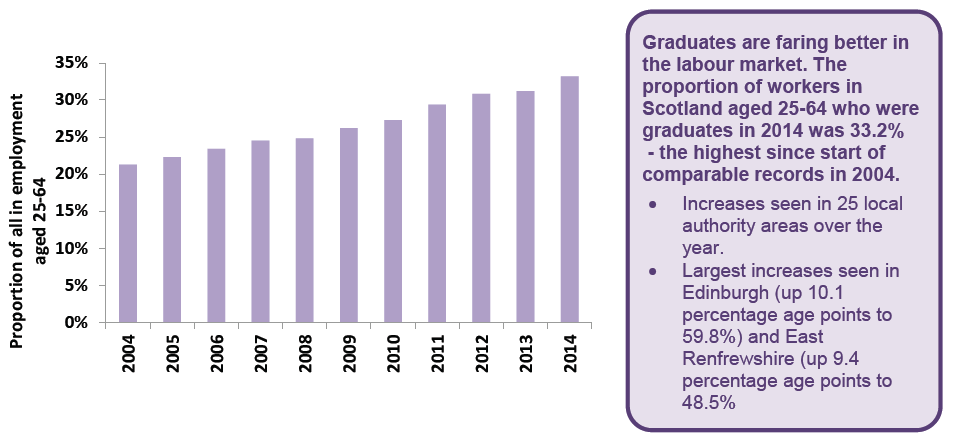
Source: Annual Population Survey, Jan-Dec 2014, ONS
Breakdown of proportion of workers aged 25-64 who are graduates by local authority area are available from Table 1.9 of the web-tables.
Work Patterns of those in employment in Scotland
Figure 17 - Work patterns by gender for all aged 16+, Scotland, change since 2008
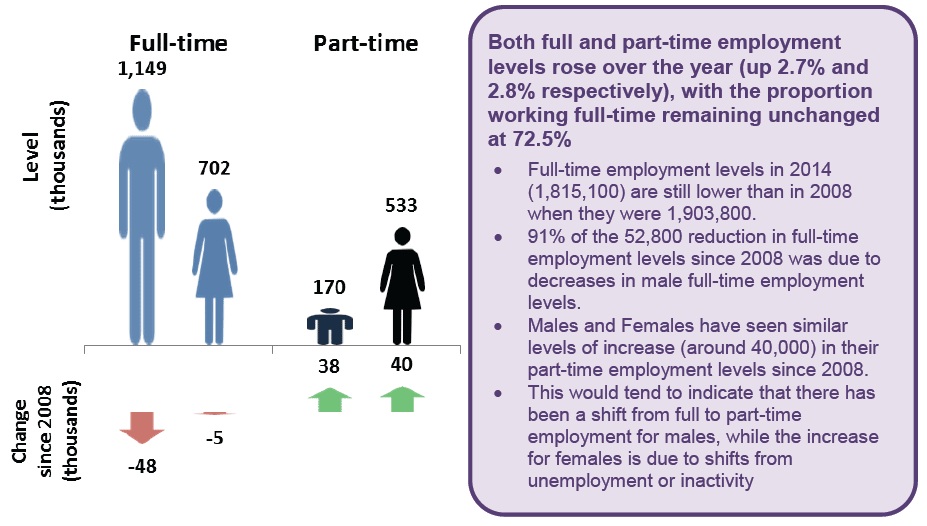
Source: Annual Population Survey, Jan-Dec 2014, ONS
Breakdowns for full and part-time work at local authority level are available in Tables 1.11 to 1.13 of the web-tables.
Levels of self-employed rose by 13,900 over the year to 301,500, slightly lower than the peak level seen in 2012. The proportion of all aged 16+ who were self-employed increased by 0.3 percentage points over the year from 11.5% to 11.8%.
Breakdowns for self employment at local authority level are available in Tables 1.14 of the web-tables.
Underemployment
As well as looking at employment rates and working patterns, it is useful to look at those who are underemployed; that is, those who are in work but who would prefer to work more hours than they do. Underemployment can provide a measure of the under-utilisation of labour. The term is also used to refer to under-utilisation of skills, however, at present the LFS only gathers information on hours based underemployment.
Figure 18 - Underemployment[5] levels by gender and work patterns, Scotland 2004 to 2014
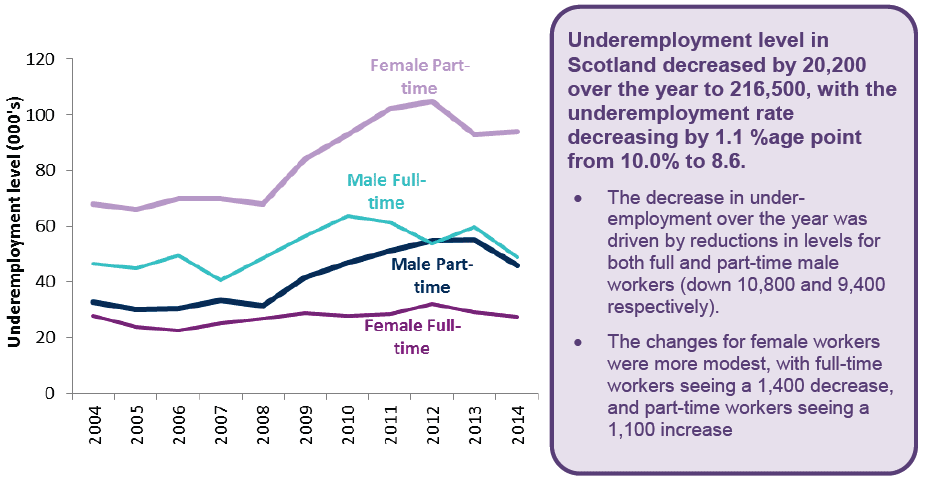
Source: Annual Population Survey, Jan-Dec 2014, ONS
16-24 year olds were the only age group to see an increase in underemployment over the year (up 1,000), with all other age groups seeing reductions.
19 local authority areas saw reductions in their underemployment rate over the year, with 10 seeing an increase and one remaining unchanged (note: estimate for Shetland Islands and Eilean Siar were below reliability threshold). However, underemployment remains higher in most areas when compared to 2008, with 25 local authorities having a higher rate, 3 having a lower rate and 1 remaining unchanged (note: estimates for all island authorities were below reliability threshold in either 2008 or 2014)
The underemployment rate in 2014 was 1.6 percentage points higher than in 2008. However, while underemployment rates for full-time male and female workers are close to their 2008 values, those for part-time male and female worker remain higher than in 2008 (3.5 and 3.9 percentage points respectively)
Breakdowns for underemployment at local authority level and by gender age and work patterns are available in Tables 1.16 and 1.17 of the web-tables.
Figure 19 - Sectoral and occupational gender segregation, Scotland, 2014
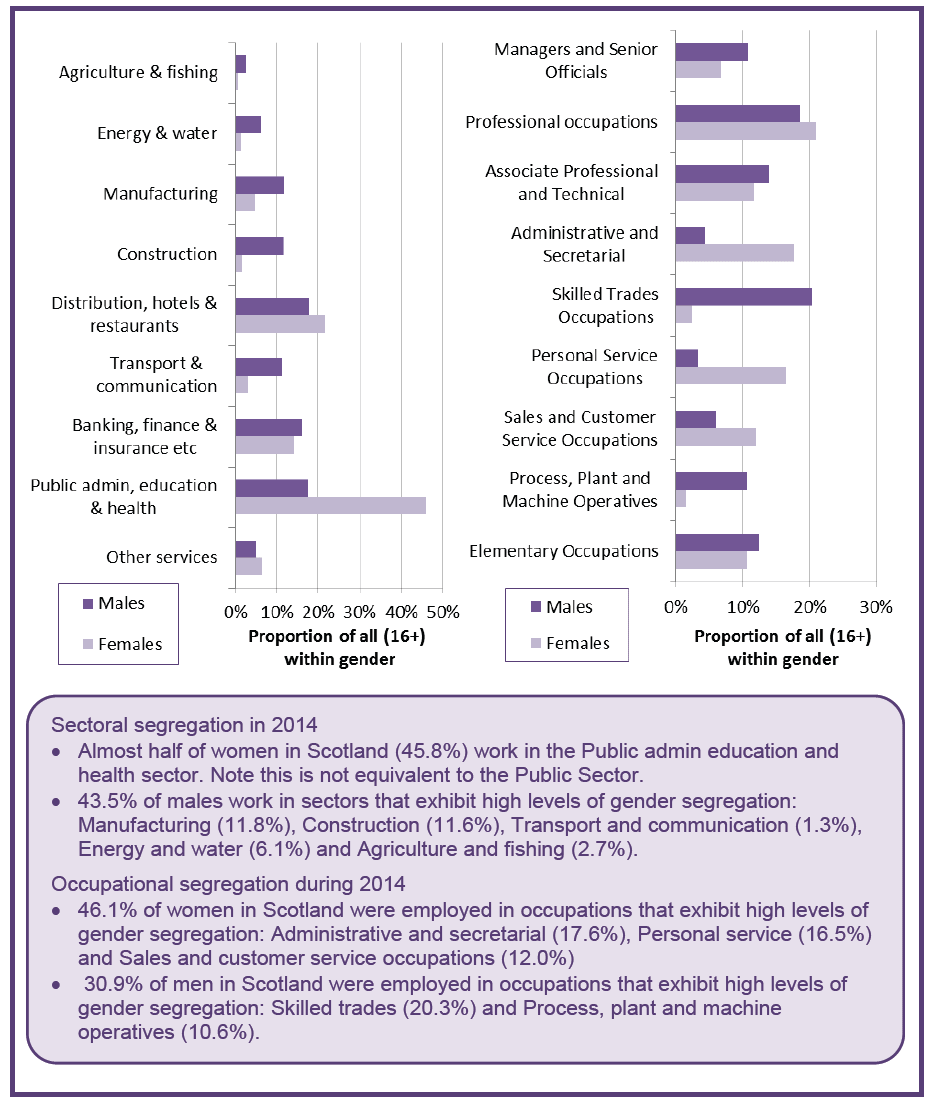
Source: Annual Population Survey, Jan-Dec 2014, ONS
Breakdowns for industry sector by gender and local authority are available in Tables 1.18 and 1.19 of the web-tables.
Breakdowns for occupation by gender and local authority are available in Tables 1.23 and 1.24 of the web-tables.
Figure 20 - Public[6] and Private sector employment levels (indexed to 2004), Scotland
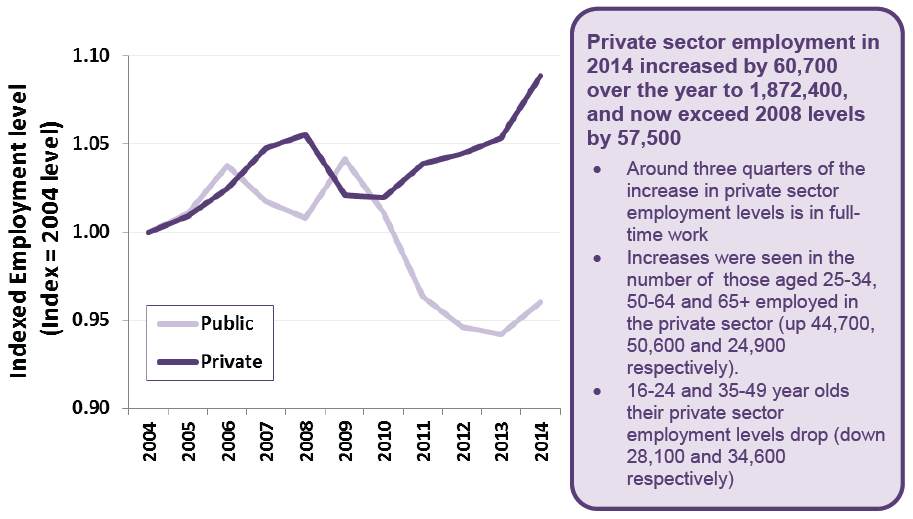
Source: Annual Population Survey, Jan-Dec 2014, ONS
Breakdowns for public, private and third sector by work-pattern, gender and disability are available in Tables 1.20a to 1.20d of the web-tables.
Breakdowns for public/private sector by gender and local authority and age group are available in Tables 1.21 and 1.22 of the web-tables.
Contact
Email: Alan Winetrobe
There is a problem
Thanks for your feedback